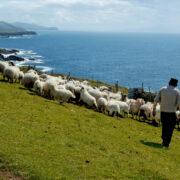Case Study – Dry Stock Farmer
How to get the most from farming without letting it destroy your life: Part 5
In the final part of this series, I will look at a part time drystock farmer to see how he might use the process outlined to help him find a solution, enabling him to enjoy life.
Case Study 2: Drystock farmer with off farm work
I spoke with John, who runs a cattle and sheep farm in the west of Ireland. He is married to Sarah. They have 5 children from 8 yrs. to 21yrs. The farm fits into what Teagasc describes as “sustainable”. The farm income is supported by off farm employment.
John tells me he finds the going very tough. He works five days per week off the farm with a half hour drive to and from work morning and evening. When he gets home from a day’s work, he usually must face several hours further work on the farm. This could take the form of feeding livestock in winter, calving cows or lambing ewes in spring or harvesting fodder in summer. He also mentioned that he gets caught from time to time for interest on merchant credit, simply because he forgets to pay some bills on time. Effectively he is neglecting his “routine responsibilities” which costs him extra money and causes him stress when this happens.
John says Sarah does not understand why he spends so many hours on the farm for so little financial return. Sarah stayed at home to look after the children while they were young. She is now thinking of returning to work part time. However, she is worried about the younger children and is frustrated with John as he rarely seems available to help out with the family.
While John loved farming all his life, he is now losing interest. He is just doing the work to get it done. As he was given the farm by his father, he feels he must take care of it before passing it on to the next generation. He wonders if he would have been better off if he never inherited the farm.
5 Essential Steps
Now, let us consider how John and Sarah might go about solving the issues that are causing them concern.
Step 1. To begin with, it is essential to look at the seven areas of life. We can see that John is concerned about a number of areas. He and Sarah need to go through each of these one by one to further clarify what the problem is. While all areas will need to be addressed over time, some will need more urgent attention. These should be prioritised. As they clarify the problem, they can then begin to visualise what the end result will look like once a solution is found (begin with the end in mind). This is the first step on the journey to their solution.
It is clear that John is concerned about not spending time with his wife. He feels their relationship is coming under stress. He says he needs to do something to address this situation. He realises he spends too much time either working in his off-farm work or engaged in farming activities. He knows his work life is dominating everything. Furthermore, he knows he has no time for recreation and while he feels he is currently in good health he does nothing specific to take care of his health. Due to being very busy, he regularly forgets to pay bills on time, which ultimately leads to an increase in his stress levels.
We can see that all of the areas that are causing worry and stress are interrelated. However, by taking a few small steps, he should be able to improve a few areas of his life. John and Sarah might decide that spending time together and reducing the workload will be the two big priorities initially.
Step 2. Secondly, they need to break this down into manageable goals. They need to identify what are the specific actions they can take to move in the right direction.
Step 3. They then need to identify options. For example, John needs to consider what are the options for reducing his workload. There could be a whole range of options if he starts to think it through. Perhaps he could rearrange hours in his off-farm work. Maybe he is running an unprofitable enterprise that could be dropped from the farm. There might be a way of employing someone for a few hours each week to do a labour-intensive task. He might also consider how he could make more time available to spend with his wife, even if only for one or two evenings per week initially.
Step 4. Once options are chosen a plan of action must be put in place to ensure it happens.
Step 5. As this plan is implemented and his goals are achieved one by one, he will gradually see some improvements in his situation. He can then start to work on another problem.
But first, he must decide to take some action.
There is little doubt that farming can be a very stressful occupation. This can lead to all sorts of problems in several areas of your life. By examining your situation, you must get clear on what problems need to be solved. You can then follow a step-by-step process to solving that problem so that you can experience the joys of life. Please note that help is available.
If you can identify with the issues discussed above, call Frank now on (087)2832761 to discuss these issues further. Further details available on www.freshpastures.ie











